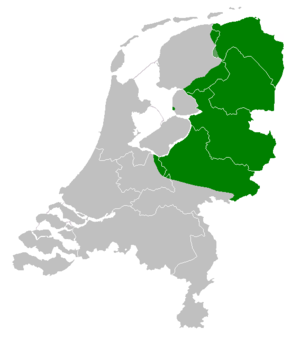Dutch Low Saxon
| Dutch Low Saxon | |
|---|---|
| Nederlaands Leegsaksies | |
| Ethnicity: | Saxons |
| Geographic distribution: |
Netherlands |
| Linguistic classification: |
Indo-European
|
| Subdivisions: | |
| Glottolog: | None |

Low Saxon dialects spoken in the Netherlands
|
|
Dutch Low Saxon (Dutch: Nederlands Nedersaksisch; Dutch Low Saxon: Nederlaands Leegsaksies) are the Low Saxon dialects that are spoken in the northeastern Netherlands. The rest of the Netherlands speaks Dutch, Frisian or Low Franconian languages. They do not form a coherent language family.
The classification of Dutch Low Saxon is not unanimous. From a point of view, the Dutch Low Saxon dialects are merely the West Low German dialects native to areas in the Netherlands, as opposed to areas beyond the national border with Germany. Some Dutch Low Saxon dialects like Tweants show features of Westphalian, a West Low German dialect spoken in adjacent Northern Germany.
From a strictly point of view, however, some linguists classify Dutch Low Saxon as a variety of Dutch. Also, as a practical matter, Dutch Low Saxon, since the 17th century, has been influenced by Standard Dutch, but the Low Saxon dialects in Germany are influenced by Standard German. Recent studies have, however, shown that mutual intelligibility is not necessarily impaired and that the basis remains the same.
Shortly after the Second World War, linguists claimed that speaking a dialect other than the standard language would impair children's (language) learning abilities. In combination with a generally condescending attitude by the upper classes of Dutch society and the media towards speakers of Low Saxon varieties (or in fact anything different from Standard Dutch), that goaded many parents to stop passing the language on to their children. It also brought about a general opinion among speakers of Low Saxon that having the slightest accent, in Dutch, would reduce job opportunities and social status.
Throughout the 1960s, the language decline inspired many to form dialect preservation circles and groups, such as the Tweants Kreenk vuur de Twentse Sproake (Circle for the Twents language) or the Drèents Huus van de Taol (House of the Language). Many of them were mainly interested in preserving rather than promoting the language. The prevailing tone was one of melancholy and nostalgia. Their focus was often on preserving cultural traits considered typical to speakers of the language, such as rural life and traditional practices, crafts and costumes. That merely confirmed many of the existing stereotypes about speakers of the language.
...
Wikipedia
